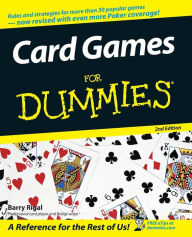Harry Lampert, a licensed teacher of the American Bridge Teachers' Association, is a Life-Master of the American Contract Bridge League and has won titles at National, Regional and Sectional tournaments. Mr. Lampert is also a nationally published cartoonist with illustrations having appeared in The New York Times, Time, True, Esquire, Saturday Evening Post and Saturday Review.
The Fun Way to Serious Bridge
Paperback
(REV)
- ISBN-13: 9780671630270
- Publisher: Touchstone
- Publication date: 05/28/1986
- Edition description: REV
- Pages: 160
- Sales rank: 47,627
- Product dimensions: 5.25(w) x 8.37(h) x 0.30(d)
.
The Fun Way To Serious Bridge is for anyone who wants to learn and understand the fundamentals of the mind-stimulating and challenging game of bridge — and enjoy every minute of it! Harry Lampert combines his skills as a bridge player and teacher with his artistic talents to bring you a totally new FUN way to learn the game. The magic of his superb cartoons and simple, informative language will help you to absorb the principles of serious contract bridge — and remember them. You'll laugh and learn every step of the way from opening bids to strip and end plays. Whether novice or seasoned social player, this unique book will make good bridge a simple "trick." You'll learn all about:
• Opening bids, suit bids, response and no trump bids, and how to force bids
• Competition and the reasons and ways behind it
• Big hand bidding such as Blackwood Convention, grand slam force and Gerber Convention
• Patterns of play including how tricks are won, the finesse, establishing a long suit, when to pull and delay trumps and entries.
• Defensive and advanced play — plus much more!
Customers Who Bought This Item Also Bought
-
- Bridge For Dummies
- by Eddie Kantar
-
- Bridge Basics 1: An…
- by Audrey Grant
-
- Bridge at a Glance
- by Audrey Grant
-
- 25 Bridge Conventions You…
- by Barbara Seagram
-
- Bridge for Bright Beginners
- by Terence Reese
-
- Bridge Basics 2: Competitive…
- by Audrey Grant
-
- Bridge Basics 3: Popular…
- by Audrey Grant
-
- The Pocket Guide to Bridge
- by Barbara SeagramRay Lee
-
- Poker For Dummies
- by Richard D. HarrochLou KriegerLinda JohnsonChris Moneymaker
-
- Beginning Chess Play: The…
- by Bill Robertie
-
- Texas Hold'em For Dummies
- by Mark Harlan
-
- Play of the Hand in the 21st…
- by Audrey Grant
-
- Power Hold'em Strategy
- by Daniel Negreanu
-
- 2 Over 1 Game Force
- by Audrey Grant Grant
-
- Bidding in the 21st Century
- by Audrey GrantBetty Starzec
-
- Small Stakes Hold 'EM:…
- by Ed MillerMason MalmuthDavid Sklansky
-
- Card Games For Dummies
- by Barry RigalOmar Sharif
Recently Viewed
Alan Truscott The New York Times ...takes the student efficiently through the basic rules of bidding...a sound introduction to play and defense.

















